
Bird watching popular in Everglades
FLORIDA CITY, Fla. — They sit perched on a lily pad, near the shrubbery or in the saw grass prairie, as if they are posing for a picture.
Birds of the Everglades National Park (ENP) along the Anhinga Trail in Royal Palm, just four miles from the Ernest Coe Visitor Center here, provide the perfect photo opportunity. Along the eight-tenths of one mile trail, visitors from all over the world point and shoot at the anhinga, herons and egrets in the saw grass prairie and the willow thicket. Some visitors bring binoculars and stare at the birds flying overhead.
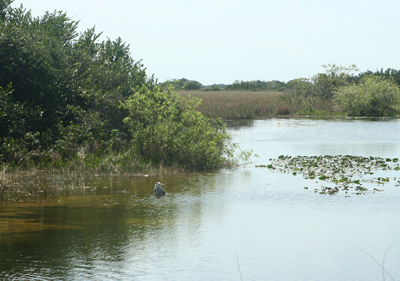 |
A Great Blue Heron submerged itself in water to cool down along Shark Valley, a peculiar and quite rare occurance according to Park Ranger Moira Ralgan (Photos by Elena Schmidt). |
“The reason there’s so much at Anhinga is that birds come where the fish is. In the winter, water level is lower so where water is left (at Anhinga) is where they gather,” said Katy Dimos, an Everglades ranger.
Claudine Laabs, an Audubon Society of the Everglades board member, first experienced bird watching in the ENP in 1981 and has not stopped photographing since.
“We came across Mrazek Pond (near Flamingo), when there was a feeding frenzy of hundreds of wading birds. It was a beautiful sight, with light coming through the birds’ wings even though I knew it was a struggle to survive and feed their young. That experience changed my life,” said Laabs.
| The Snowy Egret, which resembles the Ibis, is set apart for its “golden slippers,” or yellow feet used to entice its prey. | 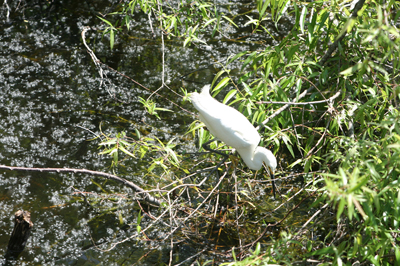 |
Bird watching is popular throughout the ENP, which consists of four major park entrances. In or around the Flamingo, Ernest Coe, Shark Valley and the Gulf Coast Visitor Centers, visitors may find a location to bird watch.
Anhinga Trail is the most popular spot, according to Dimos. While age and demographic ranges, most birders are in their 50s or older. According to Dimos, visitors travel from all over the nation as well as internationally.
“We were made a national park, not just for our scenery but for our biodiversity. Temperate and tropical birds can both thrive here,” said Dimos.
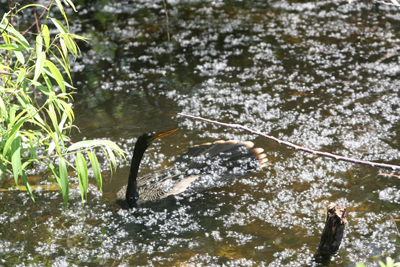 |
The Anhinga, called the “snake bird” that frequents the Everglades, is one of the few species that swims under water to catch its prey. |
While birds are out and visible, their quantity and noticeable presence in the ENP has declined over the years according to Dimos.
“It’s kind of cyclical. No one knows what this means, if anything. Where they (the birds) are, I don’t know,” said Dimos.
The Eco Pond, a former bird watching location, was closed in 2006 as a result of Hurricane Wilma and Katrina. The natural tragedies caused such a storm surge that brought saltwater into freshwater, effectively killing most of the life inside the pond.
While the ENP is great spot for bird watching, especially during dry season, prime locations may change each year. Shark Valley is the hotspot this season, where tram rides take visitors along the road to spot snail kites, anhinga, wood storks and others.
| The Tri-Color Heron poses along the Shark Valley trail, the perfect picture for birders and visitors admiring its unique colors. | 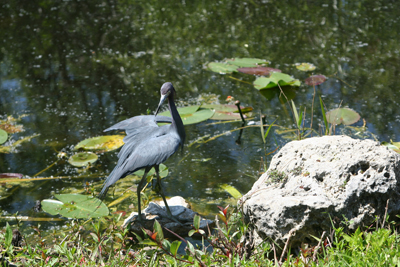 |
John Broman and his son, John Broman Jr. have revisited the Everglades since Broman Jr., now a father living in Virginia, was in grade school. After walking the Anhinga Trail one too many times, the duo decided to try Shark Valley’s tram tour.
“The Everglades is terrific. It’s very unspoiled and quite untouched. We’ve been coming here for years,” said Broman.
The Broman’s have taken their passion to “extreme birding” locations, such as Costa Rica and Trinidad, but Broman Sr., still recalls the early mornings before dawn, when he dragged his son to the Everglades for migratory season.
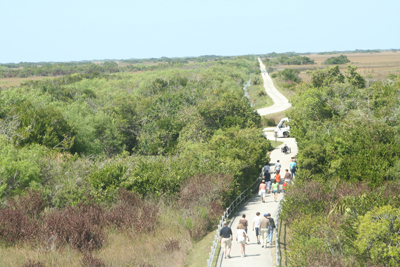 |
A view from the Shark Valley Observation Tower, where visitors may overlook the trail and park and all its colorful creatures. |
Migratory season occurs during the wet season, which starts at the beginning of spring. During this time, bird watching and visits to the Everglades dramatically declines. During Wet Season in Florida the water level rises and the ENP comes back to life. As the level rises, the wildlife disperses and become harder to spot.
For the casual birder, wet season may not provide the most lucrative first experience. For those with some time, experience and binoculars, the ENP is a prime location throughout the year according Laabs.
“Everglades National Park is situated at the confluence of several flyways so there is a high concentration of bird life, especially during migration. The vast wetlands provide foraging habitat for many species,” said Laabs.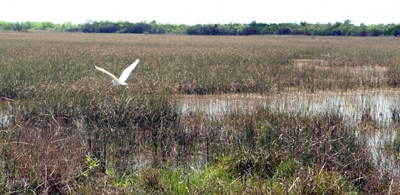
Other than the birding hotspots during dry season, veteran and amateur birders should do a little homework according Dimos who suggests that birders check the ENP map and coordinate the color with the habitat of the specific bird they desire to see.
Cynthia Plockelman, Audubon Society of the Everglades vice president, suggests that birders get up-to-date handbooks before planning a birding trip, especially during migratory season.
“Migrants will be everywhere and Royal Palm Hammock is a key spot. Otherwise, check all the poles and wires and spots lifted above,” said Plockelman.
Bird watching in the ENP can take a visitor on a trip from Homestead to the Gulf Coast, along a trail, by a pond or just outside a visitor center, providing a unique experience for everyone, everyday.
“The more I learn about birds, the more I want to know, whether it’s backyard birds like Cardinals or the regal Cranes. ‘World Peace through Birding’ is my motto,” said Laabs.
If You Go: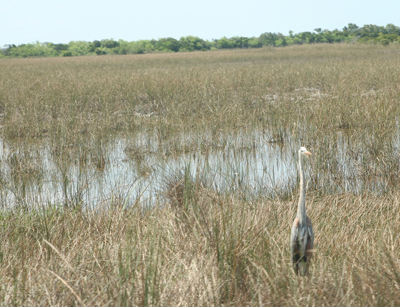
Anhinga Trail
Directions to Trail: Four miles from the main park entrance (Ernest Coe Visitor Center). Turn at Royal Palm Visitor Center.
Trail Length: 0.8 miles.
Ernest Coe Visitor Center: 40001 State Road 9336 Homestead, FL 33034-6733.
Hours: 9 a.m. – 5 p.m.
Phone: 305-242-7700, ask for Visitor Center.
Flamingo Visitor Center: Flamingo, Fla., roughly 38 miles south of the Florida City park entrance.
Hours: 9 a.m. – 4:30 p.m.
Phone: 239-695-2945.
Shark Valley Visitor Center: 36000 SW 8th St., Miami, FL 33194
Hours: 9:15 a.m. – 5:15 p.m.
Phone: 305-221-8776.
Shark Valley Tram Road: 15 miles.
Tram Tour Rates: Adults: $17.25; seniors: $16.25; children (3-12): $10.75.
Departure Times: May through late December, 9:30 a.m., 11 a.m., 1 p.m., 3 p.m. Late December through April, 9 a.m.,10 a.m.,11 a.m., 12 p.m., 1 p.m., 2 p.m., 3 p.m., 4 p.m.
Gulf Coast Visitor Center: 815 Oyster Bar Lane, Everglades City, FL 34139.
Hours: 9 a.m. to 4:30 p.m. (mid April- mid November); 8 a.m. to 4:30 p.m. (mid November – mid April).
Phone: 239-695-3311.

Comments are Closed